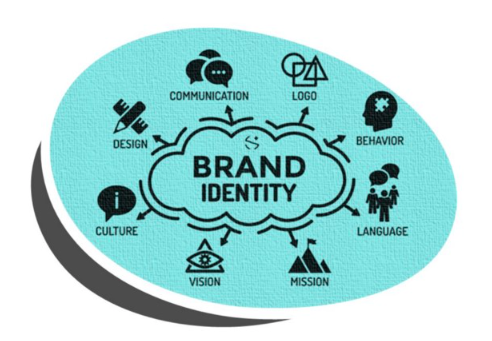In today’s competitive marketplace, establishing a strong brand identity is crucial for businesses of all sizes. A well-defined brand identity not only differentiates you from your competitors but also helps create an emotional connection with your audience. Whether you’re starting a new venture or rebranding an existing one, here’s a comprehensive guide to creating a strong brand identity that resonates with your target market.

1. Understand Your Brand’s Purpose
Define Your Mission and Vision
The foundation of a strong brand identity lies in understanding your brand’s purpose. What are you trying to achieve? Your mission statement should clearly articulate your goals and values, while your vision statement outlines your long-term aspirations. This clarity will guide all your branding efforts and help align your messaging.
Identify Your Core Values
Core values are the principles that guide your business decisions and behavior. Identify the key values that resonate with your brand, such as integrity, innovation, sustainability, or customer-centricity. Communicating these values consistently will strengthen your brand identity and build trust with your audience.
2. Know Your Target Audience
Conduct Market Research
Understanding your target audience is essential for creating a brand identity that resonates. Conduct market research to gather insights about your audience’s demographics, preferences, and behaviors. Utilize surveys, interviews, and social media analytics to gain a comprehensive understanding of your ideal customer.
Create Buyer Personas
Develop detailed buyer personas that represent different segments of your audience. Include information such as age, gender, interests, pain points, and purchasing behavior. These personas will help tailor your brand messaging and visuals to better connect with your audience.
3. Analyze Competitors
Conduct a Competitive Analysis
Examine your competitors’ branding strategies to identify what works and what doesn’t. Analyze their messaging, visuals, and customer engagement tactics. This analysis will provide valuable insights into the market landscape and help you find gaps that your brand can fill.
Identify Your Unique Selling Proposition (USP)
Your USP is what sets your brand apart from the competition. Determine what makes your product or service unique, whether it’s quality, price, innovation, or customer service. Clearly communicate your USP in your branding to differentiate yourself and attract customers.
4. Develop Your Brand Messaging
Craft a Brand Story
A compelling brand story can evoke emotions and create a connection with your audience. Share the journey of your brand, including its origin, mission, and values. Highlight the challenges you’ve overcome and the impact you aim to make. A well-told story makes your brand more relatable and memorable.
Create a Tagline
A tagline is a short, memorable phrase that encapsulates your brand’s essence. It should be catchy and convey the core message of your brand. A great tagline can help reinforce your brand identity and make it easier for customers to remember you.
5. Design Your Visual Identity
Create a Logo
Your logo is often the first impression customers have of your brand. It should be simple, memorable, and reflective of your brand’s personality. Consider hiring a professional designer to create a logo that aligns with your brand values and resonates with your target audience.
Choose a Color Palette
Colors evoke emotions and can influence customer perceptions. Choose a color palette that reflects your brand’s personality and resonates with your audience. Consider color psychology when selecting your colors—different colors evoke different feelings and associations.
Select Fonts and Typography
Typography plays a crucial role in your brand’s visual identity. Choose fonts that are legible and align with your brand’s tone. Consistency in typography across all branding materials reinforces brand recognition.
6. Establish a Consistent Brand Voice
Define Your Tone and Style
Your brand voice is the way you communicate with your audience. Define the tone and style that best represent your brand, whether it’s professional, friendly, casual, or authoritative. This consistency in voice should be reflected in all written communications, including social media posts, blog articles, and marketing materials.
Create Brand Guidelines
Develop comprehensive brand guidelines that outline your brand identity elements, including logo usage, color palette, typography, and voice. These guidelines ensure consistency across all platforms and materials, helping to reinforce your brand identity.
7. Implement Your Brand Identity
Apply Across All Channels
Once you’ve developed your brand identity, implement it across all customer touchpoints. This includes your website, social media profiles, packaging, email marketing, and advertising. Consistency is key; your brand should be easily recognizable no matter where customers encounter it.
Train Your Team
Ensure that your team understands and embodies your brand identity. Provide training on your brand values, messaging, and voice, so everyone in your organization represents your brand consistently.
8. Monitor and Evolve Your Brand Identity
Gather Feedback
Regularly seek feedback from your audience to gauge how well your brand identity is resonating. Use surveys, social media engagement, and customer reviews to gather insights. This feedback can inform adjustments to your branding strategy.
Adapt and Evolve
The business landscape is constantly changing, and so are consumer preferences. Be open to evolving your brand identity as needed while remaining true to your core values. Regularly revisit your branding strategy to ensure it aligns with your audience and market trends.
Conclusion
Creating a strong brand identity is a strategic process that requires careful planning and execution. By understanding your purpose, knowing your audience, and developing a cohesive visual and messaging framework, you can establish a brand that stands out in a crowded marketplace.


No responses yet